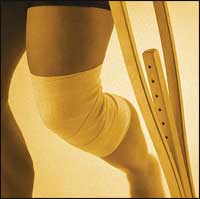WebMD reports that by applying ergonomic solutions, individuals may be able to reduce health problems and improve their comfort and ability to work effectively.
People can reduce their chances of incurring musculoskeletal injuries and be more comfortable and efficient by setting up their workstation and work tools to suit their own personal needs:
- The chair should have an adjustable seat height, back, and arm rests, and a base with five wheels for easy movement without tipping. Lumbar support for the back is helpful. When sitting in the chair, an individual’s feet should rest flat on the floor, and their thighs should be parallel to the floor. The edge of the chair should be soft and should not touch the backs of the knees. If there are arm rests, the sitter should be able to use them without slouching or having his or her shoulders either hunched up or drooping down.
- The desk should be adjustable for height and large enough to accommodate the individual’s work area. People should arrange the desk so the items they need most often are within reach, and so they don’t have to bend or twist frequently.
- The keyboard tray should be big enough to hold the keyboard and mouse, and the height should be adjustable.
- A footrest can help support the individual’s legs and reduce low back strain, especially if his or her feet don’t rest comfortably flat on the floor.
- The computer monitor should be directly in front of the individual. The height should be adjustable, with the top of the screen at about eye level.
- The computer mouse can be a trackball or touch pad, which may help reduce symptoms some people get from the repetitive motions of a standard computer mouse.
- The computer mouse should be placed on the keyboard tray close to the keyboard to eliminate excessive reaching.
- Contoured or curved keyboards are designed to help reduce problems in the hands, wrists, and shoulders. They seem to help some people, but there is no firm evidence that they reduce symptoms. Wrist pads (also called wrist supports or wrist rests) help support the arms and reduce strain during breaks from typing. The pads are actually not intended to be used while the individual is typing. Some people find the pads helpful even when they are using their keyboard or mouse. When individuals type or use their mouse, they should try raising their forearms a little so their wrists are in a neutral position and their arms and hands can move freely. If an individual has arm rests on the chair, he or she may be able to adjust them so their forearms are parallel to the floor and their wrists are neutral. Individuals may want to alternate between resting their wrists on the pads and raising them up. If a wrist pad is used, it’s best to rest the palm or the heel of your hand on the support, rather than the wrist.
Good posture will also help prevent musculoskeletal injuries. Using good sitting posture, relaxing the shoulders, keeping the feet flat on the floor, and avoiding leaning close to tasks on the desk. Individuals should turn their whole body to the task instead of twisting.
People who work in office mail rooms where lifting is often necessary sometimes use back belts. There is no clear evidence that back belts help reduce strains and other injuries due to lifting. Some experts believe the use of back belts may even increase individuals’ chances of injury by making them overconfident or allowing their muscles to get weak. To lift safely :
- Keep the object you want to lift close to you.
- Bend your knees and keep your back straight as you grasp the object, then straighten your knees to lift it up.
- Don’t try to lift something by yourself that is too heavy, too awkward to carry, or that will not allow you to see where you are walking.
- Try a golfer’s lift for very light objects such as a pen or piece of paper. Bend one knee slightly and allow your other leg to come off the floor behind you as you bend over. Hold on to a desk or stable chair for support.
Falls are common causes of injury in the office. To help prevent falls, keep walkways clear of cords, clutter, and spills. Close drawers completely after you use them. Use stepladders instead of chairs to reach high objects. Report any hazards such as loose carpeting or burned-out lights. And wear shoes appropriate to your job and environment.
Good general health, including strength and flexibility, can help prevent injuries. It will also help individuals recover faster if they are injured.
[Source: WebMD]



